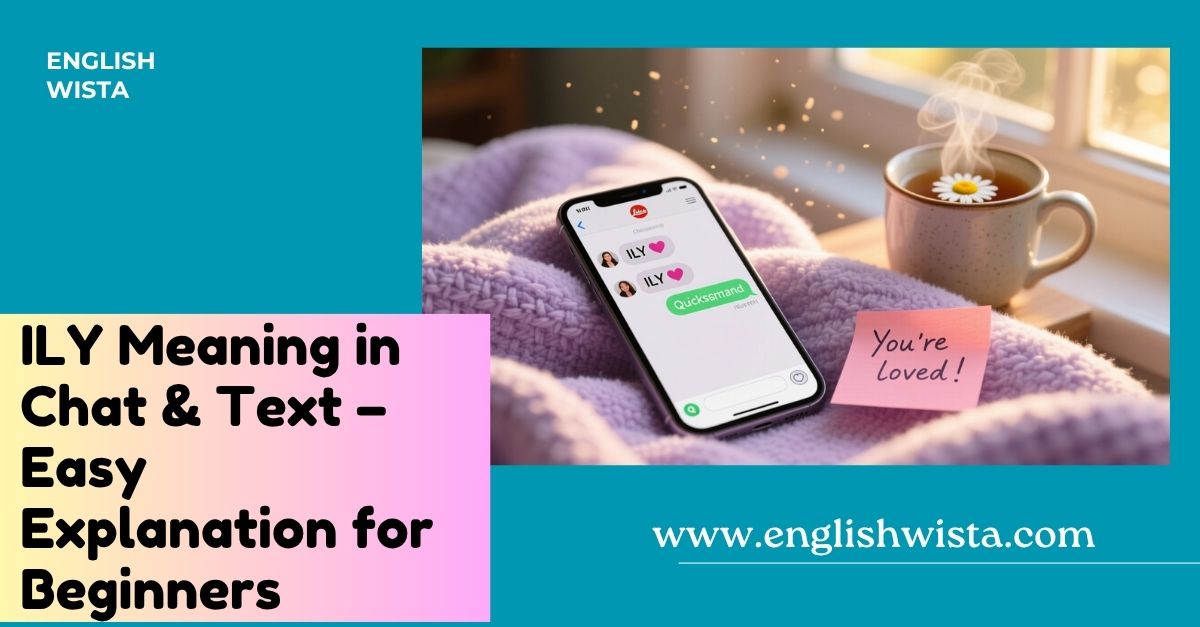Have you ever been scrolling through your messages or chatting with a friend online and suddenly see the letters “ILY” pop up? Maybe you wondered if it was a typo, or maybe you guessed it had something to do with love. If you weren’t sure, don’t worry, you’re not alone. The world of texting and internet slang is full of short forms, and they can feel confusing if you don’t use them every day.
One of the most popular and affectionate abbreviations out there is “ILY.” It’s short, sweet, and powerful. People use it in friendships, family conversations, and romantic chats. In this article, we’ll break down exactly what ILY means, how it’s used, where it came from, and how you can confidently use it in your own messages.
By the end, you’ll not only understand this abbreviation but also feel comfortable recognizing and replying to it in everyday chats. So, let’s get started!
What Does ILY Mean in Chat?
The abbreviation ILY stands for “I Love You.”
It’s one of the most common ways people express affection quickly in texts or social media. Instead of typing out the full phrase, people just use the three letters. It saves time, looks cute, and still communicates the same warm feeling.
So if someone types:
- “Goodnight, ILY” → They’re really saying “Goodnight, I love you.”
- “ILY bestie!” → They’re saying “I love you, bestie!” in a friendly way.
It’s short, but it carries a lot of emotion.
Why Do People Use ILY Instead of Writing “I Love You”?
There are a few reasons why people prefer to type ILY:
- It’s Faster – Texting is often quick and casual. Writing three letters is much faster than typing out the whole phrase.
- It Feels Playful – The abbreviation gives a lighter, more casual vibe, which works well in friendly or informal conversations.
- It’s Less Intense – Sometimes, typing “I love you” can feel too heavy or too serious, especially in new friendships or relationships. “ILY” softens it.
- It’s Trendy – Internet culture loves abbreviations, and this one has become a standard.
Think of it this way: ILY is like a friendly shorthand. It’s affectionate, but it doesn’t always carry the same deep weight as typing out the full words.
Is ILY Only for Romantic Relationships?
Not at all! This is a common misconception. While ILY can definitely be used between romantic partners, it’s also very popular among friends and family.
Here are a few examples of non-romantic uses:
- Friend to friend: “Thanks for always being there for me, ILY.”
- Parent to child: “Good luck on your exam today. ILY!”
- Between siblings: “You’re so annoying sometimes, but ILY anyway.”
As you can see, it works in different relationships. The tone depends on who you’re talking to and how you say it.
Variations of ILY You Might See
Internet slang is always evolving, so people have come up with creative twists on ILY. Here are some common ones:
- ILU → Another short version of I love you.
- ILYSM → I love you so much.
- ILY2 → I love you too.
- ILYM → I love you more. (often used playfully when two people go back and forth saying it).
- ILYA → I love you always.
Each variation adds a little extra flair or emotion. For example:
- “Good luck on your trip, ILYSM!” feels much stronger than just “ILY.”
How to Reply When Someone Says ILY
So, what do you do when someone sends you ILY? Your response depends on how you feel about the person and the situation.
Here are some possible replies:
- If you feel the same way:
- “ILY too!”
- “Love you more 🥰”
- “Aww, ILYSM!”
- If it’s a friend and you want to keep it casual:
- “ILY bestie!”
- “Thanks, ILY2.”
- If you’re not sure how to respond:
- “That’s sweet, thank you ❤️”
- Or just send back a heart emoji ❤️ or 💕.
Remember: You don’t have to overthink it. The key is to match the energy of the other person.
Real-Life Examples of ILY in Chats
To make things clearer, here are some examples of ILY in real conversations:
- Between Friends
- Alex: “You’re the only one who gets my weird jokes 😂.”
- Sam: “Haha, same here. ILY bestie.”
- Between Romantic Partners
- Mia: “Goodnight, babe. Sweet dreams.”
- Leo: “Goodnight, ILY.”
- Between Family Members
- Mom: “Don’t forget your lunch on the counter.”
- Teen: “Got it. Thanks, ILY.”
These examples show how natural and flexible ILY is in everyday texting.
Where Did ILY Come From?
Like many internet abbreviations, ILY grew popular in the early days of online messaging and text culture. Back when people had to type on tiny phone keyboards or pay per text, abbreviations became a lifesaver.
Instead of writing long sentences, people shortened phrases to make texting faster and cheaper. That’s how “ILY” became a favorite for expressing affection.
Today, it’s widely used not only in texts but also on social media platforms like Twitter, Instagram, and TikTok.
Fun Facts About ILY
Here are a few interesting tidbits about this little abbreviation:
- ILY is universal. Even though it’s an English abbreviation, people around the world use it in online conversations, no matter their native language.
- There’s also a sign for ILY. In American Sign Language (ASL), the hand sign 🤟 combines the letters I, L, and Y. Many people use this emoji as a fun alternative to typing ILY.
- It’s one of the most positive abbreviations. While some internet slang can be sarcastic or confusing, ILY is almost always affectionate and kind.
Common Confusions with ILY
Because it looks so simple, some beginners might mix up ILY with other acronyms. Here are clarifications:
- ILY ≠ ILM. ILM can mean Islamic Learning Materials or Industrial Light & Magic, which is very different!
- ILY ≠ IRL. IRL means In Real Life.
- ILY ≠ ILYM. That’s a stronger form meaning I love you more.
So if you see ILY, just remember it’s always about love or affection.
When Should You Avoid Using ILY?
Even though it’s a sweet expression, there are moments when it might not be the best choice.
- In professional settings. You wouldn’t text your boss: “Thanks for the update, ILY.”
- With strangers. If you just met someone online, saying ILY too soon might feel weird.
- In serious or formal conversations. It might look out of place if the topic is sensitive.
In general, ILY works best in casual, friendly, or loving conversations.
Comparing ILY With Other Affectionate Phrases
To understand ILY better, let’s compare it with some similar abbreviations:
- ILY vs. XOXO:
- ILY = I love you.
- XOXO = Hugs and kisses.
- Both show affection, but ILY is more direct.
- ILY vs. <3 (Heart Emoji):
- ILY uses letters.
- <3 is a symbol that looks like a heart.
- Both are cute and affectionate, but <3 is more visual.
- ILY vs. ILYSM:
- ILY = I love you.
- ILYSM = I love you so much.
- The second one is more intense.
Why Learning Slang Like ILY Matters
If you’re new to English or to online culture, learning abbreviations like ILY can really help you feel connected. They make conversations faster, warmer, and more natural.
Understanding these small expressions prevents confusion and helps you respond in the right way. Plus, it’s fun! Once you learn one abbreviation, it gets easier to understand others like BRB (Be Right Back) or OMG (Oh My God).
Quick Review: Key Points About ILY
- ILY means “I Love You.”
- It’s used in romantic, friendly, and family conversations.
- Variations include ILYSM, ILY2, and ILYM.
- You can reply with “ILY too,” emojis, or other affectionate phrases.
- It’s casual, playful, and best used in informal settings.
Conclusion: ILY in a Nutshell
So, now you know! The next time someone sends you “ILY,” you’ll immediately understand that it means “I love you.” It may look small, but it carries a big message of affection and care.
Whether it’s from a partner, a friend, or a family member, those three letters can brighten your day. And now that you’re familiar with it, you can use it yourself to spread a little love in your chats.
So go ahead, try sending an ILY to someone you care about today. You might be surprised at how such a simple abbreviation can make someone smile.
And with that, I’ll wrap up by saying: ILY for reading this guide!



